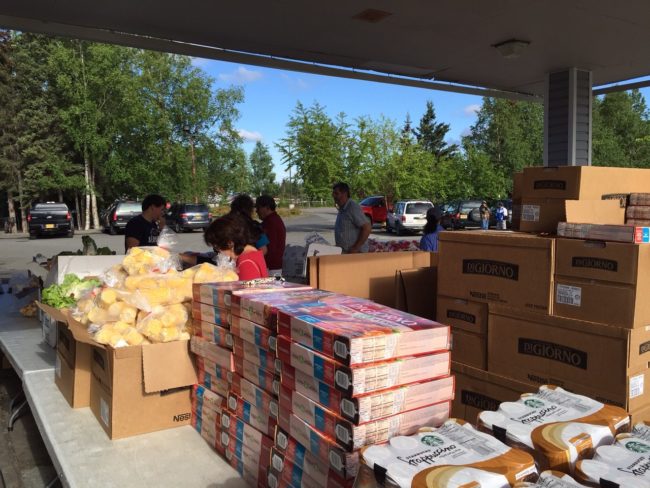
Every week in 2014, nearly 6,300 households received free food from food pantries and other programs in Alaska. At some point, most of them had to choose between food or transportation, rent, medical care, or heat. Data from the United Way shows that the need is rising statewide. For some, mobile food pantries help close the budget gap.
70-year-old K Fong darts around the parking lot near the entrance of the Muldoon Community Assembly Church, pointing at tables loaded with food.
“Always this end, the veggies, the pastry, the bread, the apple,” he says pointing to a box filed with fruit at the far end.
Fong says he found out about the mobile food pantry a couple of years ago when an elderly neighbor received a box of food. Fong needed help himself, so he visited the pantry then decided to volunteer, too. He only takes food when he needs it and even then, “I share with a lot of different people.”
The food is stacked by type then counted. The quantity is divided by the number of people who show up — usually 80 or 100. During this event, each family will receive two cartons of juice, a case of Frappuccinos, two boxes of frozen pizza, and their choice of vegetables ranging from salad greens to parsnips and celery root.
“If there are any leftovers, then you can come back for seconds, everybody (is) equal,” Fong says. “And if you feel like, ‘I don’t use this,’ you don’t have to take them.”
Inside the church people line up waiting for numbers. They go through the line on a first-come, first-served basis.
Among them is Pamela Notti. She says she works 40 hours per week but once she pays her rent, car insurance and student loans there’s nothing left for food.
“You know, who’d have thought I’d go to college and get a bachelor’s degree, then a master’s degree, then end up here being a consumer here at food bank, but it happens. And the people here make you feel really welcome,” Nottie says.
She’s been receiving food for about five months since moving back to Anchorage from Bethel. She says at first it wasn’t easy to ask for assistance.
“Sometimes I just have to put my pride aside and say, ‘You know, I’m part of the community, too, and regardless of what my educational level is there’s times I need help.’”
Notti isn’t alone. About 60 percent of the people receiving food help in Alaska in 2014 had been working in the past 12 months. Most of the others were retired or disabled.
Sue Brogan with the United Way says the 2-1-1 resource referral line has seen a nearly 50 percent increase in the number of referrals for food help statewide from 2012 to 2014. Brogan says it’s another coping tool — help isn’t available to pay for utilities or rent directly, so people have to juggle their budgets.
“Individuals are using food pantries as a mechanism to supplant or pay their monthly bills. In order to stay housed and pay their utilities, they can go visit a food pantry,” she says.
Food Bank of Alaska Mobile Food Pantry Coordinator Sandra Mitchell says the mobile food pantries serve a practical purpose; they help get donated, perishable foods into the hands of people who need it before it goes bad. The Food Bank of Alaska has distributed more than 7 million pounds of perishables since the mobile program started in 2006. It’s about 3,000 to 5,000 pounds per pantry, depending on what’s been donated. But as Mitchell looks at the community members and volunteers chatting and joking, she says it’s about more than just food.
“It helps people too not just with nutritional health but with wellness and stability and knowing that there’s someplace they can come and not just receive food but receive something else also.”
There are at least four food pantries per week in Anchorage. The Food Bank also provides supplies for rural areas.
